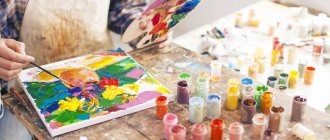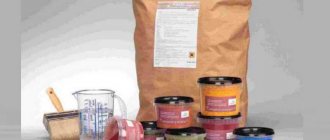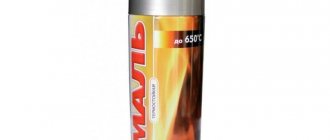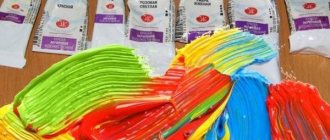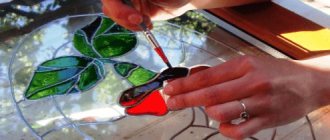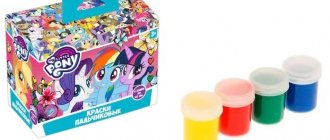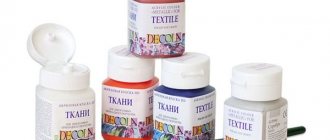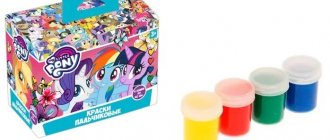When you want to create paintings so that they are preserved for many years, you should choose the right base for them and the paint that matches your request. The process of drawing can make you fall in love, because it allows you to reflect your creative abilities and thoughts. What nuances you should pay attention to when choosing canvas and paint will be discussed below.
Choosing paint for painting on canvas
Previously, to create durable works, artists could only choose oil paints that could last for centuries. Modern technologies have made it possible to develop a new type of paint using acrylic as a base.
Acrylic paints are loved by many creators for their variety of colors and ease of use. They are often used to create modern styles of painting - abstractions or posters. The choice is made based on the preferences of the artist himself and the task at hand: what effect they want to achieve in the end.
You can use both compositions on the same painting; there is no prohibition on using oil and acrylic compositions together.
Acrylic paints are loved by many creators for their variety of colors and ease of use.
Acrylic paints
This type is distinguished by the fact that water is used as a base. If the paint needs to be diluted, then water is added, and after drying, a moisture-resistant coating is created. For this reason, the picture will be stored for a long time without changes. However, the drying process causes the colors to darken, which should be taken into account when using.
Artists note other advantages:
- Drying takes little time;
- No cracks appear on the canvas;
- There is no need to apply varnishes or other means on top for a fixing effect;
- Versatility of use, you can work on wood, metal, glass and canvas.
In paintings by numbers, acrylic compositions are used.
The drying process causes the colors to darken, which should be taken into account when using.
Oil paints
The oil type includes vegetable oils as a component, which helps to form a film-like protection against water on the surface after drying. It was this type that was used to create masterpieces of painting. Once the layer has dried onto the surface, it does not change tone.
The standard base for artistic paints is linseed oil. To successfully work with this type, you should prime the surface of the canvas before applying paint.
The oil type includes vegetable oils as a component, which helps to form a film-like protection against water on the surface after drying.
The main differences between acrylic and oil paints
Paint for canvas, which one should I use? Comparing the two types can help you decide. So, those based on acrylic are classified as synthetic products, while the latter can be made from natural elements.
The former are distinguished by darkening of color after drying, the latter do not change the brightness of the shades. To work with oil paints you need to use a primer solution, but not for acrylic paints.
The former are distinguished by darkening of color after drying, the latter do not change the brightness of the shades.
Which is more convenient for beginners
A novice painter should begin to paint with means that are easier to use when working. Among the two means that can be distinguished for this purpose is acrylic.
They can be diluted with plain water to obtain the required thickness. They dry quickly and adhere well to the surface. There is no need to purchase additional compounds for the drawing process.
Acrylic paints dry quickly and adhere well to the surface.
Acrylic
The golden mean of artistic materials, which few people know about. Acrylic is often confused with watercolor because of its name, and with gouache because of its appearance, but they are not at all similar.
Completely different from oil, they dry in the shortest possible time, sometimes even faster than watercolor. But at the same time they have a slightly oily consistency.
After the layer has dried, you can put the next one on top of it, and if you make a mistake, immediately wipe it off with a cloth. The paints just applied will be erased, but the previous layer will remain untouched. This is very helpful when learning acrylics and getting to know paint.
Acrylic fits perfectly on any material, it is not picky in application, paper, cardboard, canvas, wood, plastic, glass and even metal are suitable for it. You can also use acrylic to create volume and give life to a painting, making it more realistic.
If you dilute the color with water on the palette and paint on the “wet” side, you create a watercolor effect, but without dilution and work on the “dry” side, the paint looks like gouache or oil. You can stick paper tape onto the dried layer; after removal, it will not leave marks and the paint will not be damaged.
What fabric are oil canvases made from?
The canvas for oil painting should also be selected with knowledge of certain features. To obtain a long-lasting result, the quality of the base is also important. For this reason, types of canvases are studied.
To obtain a long-lasting result, the quality of the base is important.
Cotton canvases
The cotton type began to be used not so long ago, less than 100 years. Artists appreciated his positive qualities. These include:
- Acceptable price;
- The texture is even and smooth;
- With a good degree of tension, drawing on it is comfortable.
However, there are also disadvantages of the material:
- Low degree of resistance to deformation;
- Changes in temperature and high humidity can lead to sagging.
With a good degree of tension, drawing on it is comfortable.
Linen canvases
This is the most optimal option, because it was on linen that masterpieces of painting were created that were preserved for centuries. The following advantages are noted:
- Strength, resistance to mechanical loads;
- Does not absorb moisture;
- Low degree of sagging;
- There are different grain canvases suitable for different painting techniques.
Flaws:
- Not everyone appreciates the relief of the base;
- A more expensive option compared to cotton.
This is the most optimal option, because it was on linen that masterpieces of painting were created that were preserved for centuries.
Synthetic canvases
Fabrics made of synthetic materials, based on threads of yarn made from polyester. The advantages described below are noted:
- Strength characteristics;
- Does not rot;
- Does not change structure due to high humidity.
Minuses:
It is impossible to say about the long-term service life of the canvas; it was not possible to check this; they began to be used recently.
Does not change structure due to high humidity.
Canvas sizing
To improve the properties of the canvas, painters often resort to pre-sizing the canvas. This makes it possible to obtain a better basis for creating great works. You can purchase sizing or make it yourself.
To improve the properties of the canvas, painters often resort to pre-sizing the canvas.
Basic properties of sizing
Sizing is used because of several positive properties of this process. To avoid seepage of primer solution and paints through the canvas. Thanks to sizing, the consumption of products is reduced and the strength of the paint coating is improved. It imparts antiseptic properties to the base. Helps extend the life of the coating.
Thanks to sizing, the consumption of products is reduced and the strength of the paint coating is improved.
The best acrylic paint for wood – BRAUBERG
When you google wood paints, it mostly comes up with exterior paints. What I'm talking about is what kind of paint you can use for wood painting or small furniture remodeling projects.
In fact, any high-quality acrylic paint will work on wood. What is more important is not the choice of paint, but to properly treat the wood, sand it for painting and paint, so that the surface is smooth and does not absorb too much paint.
Recommended acrylic paints for wood:
- Pebeo
- Brauberg
Why prime a painting?
Priming the surface helps improve the adhesion of materials to each other. Obtain the required texture and background for further paint application. For acrylic paints, you can skip this step.
Priming the surface helps improve the adhesion of materials to each other.
Types of soils
There are several types of primer mixtures suitable for working with canvas. They have different properties, knowledge of which will help you choose the right option for a particular task. Highlight:
- Glue is used for oil paints; products dry on it faster and do not crack;
- Emulsion does not dissolve in water, suitable for all types of canvases. Can be used with any paints;
- Oil paint is intended for paints of the same name, but the drying stage will take at least 12 months;
- Acrylic is suitable for oil, acrylic and tempera paints and can be applied to different canvases.
There are several types of primer mixtures suitable for working with canvas.
Pastel
When you see pastels, you don’t recognize them as paints at all, because they look like children’s wax crayons. To draw with pastels, you do not need water or brushes (only in rare exceptions), but only the crayons themselves and paper or canvas. Despite this, pastel is still "paint". All pastels are divided into four types: dry, oil, wax and watercolor.
Wax crayons, which children often use to draw, are a type of pastel, but few people know about it, and the artists themselves do not like to use the wax variety, unless they are book illustrators.
Dry, in turn, is also divided according to softness. Ultra-soft contains almost no binding component, thanks to which hardening is achieved.
That's why they sell it in jars and paint it with sponges. Dry is the most common among pastels. It applies softly and easily to paper, blends well and mixes shades perfectly. Dry pastels are also often combined with other paints, such as watercolors or acrylics, and most often all types of softness are used at once.
The only negative is the fragility of the finished work; it can easily be damaged by careless movement, so it is either sprayed with a special solution or placed in a frame under anti-reflective glass. Such glass is often used in art galleries, not only for paintings made from this paint.
Oil pastels are quite harmful material. It does not allow shading, and its colors hardly mix or are extremely reluctant to do so, but in itself it does not require additional fixation. The material itself seems a little greasy to the touch.
Watercolor pastels can be blurred with water, which adds the effect of watercolor painting and airy lightness to the work.
Canvases by type of base
Canvases for painting with acrylic and other paints are also divided according to the type of base. Determines the strength of paint and canvas retention, the possibility of adjustment in case of sagging work.
Canvases for painting with acrylic and other paints are also divided according to the type of base.
Canvas on cardboard
Cardboard for drawing is immediately ready for drawing; the primer is applied at the production stage. Can be used by beginners and professionals. Low cost, suitable for acrylic and oil paints.
Cardboard for drawing is immediately ready for drawing; the primer is applied at the production stage.
Canvas on stretcher
There are two types of subframes - modular and solid. The first one helps to easily adjust the tension of the canvas and is also easy to disassemble for storage. The second type is not a suitable option for beginning artists; adjusting the sag is not possible quickly; the canvas must be completely re-stretched.
There are two types of subframes - modular and solid.
Canvas in roll
The roll type involves further cutting the canvases to the required sizes; this is an advantage; if you plan to draw a lot, larger sizes are sold. After cutting, the canvas is independently pulled onto the stretcher.
The roll type involves further cutting of the canvas to the required dimensions.
Butter paper
For further painting with oil paints, special impregnations are used in the production of this paper. Natural cellulose is used, the structure resembles canvas in relief.
For further painting with oil paints, special impregnations are used in the production of this paper.
Which children's paint is better to buy?
Knowing how to choose children's paints is important, since not only the result of creative efforts, but also the safety of the child depends on it. The main factor when purchasing should be the safety of the products, especially for young children. When choosing, it is also important to pay attention to ease of use, saturation, color fastness, so that the work does not fade in the sun over time. The purchase price also plays an important role.
Among the entire rating, the following nominees can be distinguished, taking into account their main advantages:
- Jovi can be called the best finger watercolors. They are gluten-free, economical and suitable for children from birth.
- Sonnet, according to users, is the leader among watercolor palettes. These are suitable for preschool children. Experts note their safe composition, lack of odor and dense, uniform texture without impurities.
- Ray Zoo stand out in the gouache watercolor category. They do not spread, dry quickly, and wash well from any surface or clothing, so they are suitable for schoolchildren.
- Brauberg is named the best among acrylic gouaches. Waterproof, have excellent pigmentation, suitable even for professional artists or students.
- Ladoga distinguished itself among oil watercolors. It is suitable even for beginners, it is lightfast, bright, and has a large palette.
You can buy children's paints in artist salons, stationery stores, or order online. When choosing one type or another, you should take into account their purpose and the age of the child, and before purchasing, you need to study information about the manufacturer.
Canvas grain
The grain of the canvas can be different, this helps to obtain different designs. The types are suitable for creating various techniques, and are chosen by the artist based on the general idea.
The grain of the canvas can be different, this helps to obtain different designs.
Fine grain canvas
The fabric has a smooth texture. More suitable for painting in thin layers. It is very convenient to write down the smallest elements on such a basis, emphasizing the details.
More suitable for painting in thin layers.
Coarse canvas
Usually chosen to create large sized works. Under mechanical loads, the structure does not change. A suitable option for impasto painting.
Usually chosen to create large sized works.
Scenic canvas
Suitable for oil paints; not used with acrylic and tempera paints due to their ability to allow moisture to pass through. Made from 100% linen fabric. Resistant to stretching and sagging, even when thick layers of dyes are applied.
Made from 100% linen fabric.
Canvas size
The size range of canvases is very diverse. Every artist can find a suitable option for themselves without difficulty. When choosing, he is guided by his own preferences. If you don’t know in advance what kind of painting it will be, then you can purchase a rolled version and cut it to the required size when you come to inspiration.
The size range of canvases is very diverse.
Which brand of children's paints is better to choose?
The stores offer a fairly wide selection of watercolors. They differ in appearance, color, texture, volume and composition, which should be paid special attention to. Also, when purchasing, you need to take into account the manufacturer, who must have a good reputation. Therefore, users prefer well-known, proven brands that have earned trust due to their popularity and good quality products.
The rating considers companies that produce only the best children's paints:
- MultiArt is a well-known Russian manufacturer offering kits for children's creativity. Focuses on role-playing and educational lines, in the production of which it uses images that are recognizable to everyone.
- Jovi is a company from Spain, founded in 1939. When making toys, it uses only environmentally friendly materials, constantly improving production technologies.
- Gamma is the largest brand from Russia producing kits for hobbies and creativity. Created in 1899, the holding has received many awards for excellent product quality, and is therefore considered one of the best.
- Erich Krause is a popular concern producing reliable office supplies. A leader in recognition, Erich Krause has become one of the most purchased brands in Russia over the past time.
- Sonnet is a brand that produces professional gouaches. It offers a large selection at affordable prices, and uses light-resistant organic pigments in its production.
- Luch is another manufacturer from Russia that produces kits for children's creativity. All brand products are certified according to two international standards and are marked with CE/AP marks.
- Brauberg is a well-known company that produces products for the office, schoolchildren, and artists. It presents a wide range of paints for children, producing them in factories in Europe and Southeast Asia.
- Ladoga is one of the largest brands producing creative products. Offers professional rulers and produces watercolors based on natural organic components.
What to look for when choosing a canvas
Recommendations from professionals can help when choosing a canvas for the job. The following tips can be highlighted:
- If the surface is already primed, then it is necessary to check its integrity; there should be no cracks or other defects;
- The degree of tension is important, to make sure that it is sufficient, press the canvas with your finger, returning to its previous state should take no more than a minute;
- The canvas is installed on a flat base, and they look at the distance from the corner to the surface; it should not be higher than 3-5 mm.
The degree of tension is important.
Artists must pay special attention to the choice of paints and canvas. The durability and colors obtained at work depend on their quality. It is easier to perform various painting techniques on special bases, for this reason the choice should be made with knowledge of their specifics.
Unusual colors
Glitter paints . They are not recognized by professionals, but for children of all ages they are a favorite toy, and amateur artists love to add an unusual, special touch to their work.
Mother of pearl . They are similar to glitter paint, but they shimmer on their own, thanks to the glitter crushed into pollen. These paints are used less often, but once you try it, it’s impossible to stop.
Watercolor pencils . This is a watercolor turned into a pencil lead. At first it seems that it is no different from ordinary pencils, but it is enough to take a clean brush and blur the drawing with water, and we immediately get a watercolor painting. It also looks like watercolor pastel.
Acrylic for fabric . Paint specially made for craftsmen who want to create their own and individual things. What distinguishes it from the usual one is that after drying it cannot be washed or scraped off.
Neon . Glow in the dark colors. There are the same materials for fabric. Clothes with this pattern are very popular among artists. And in regular drawings, this can be used for the effect of surprise, or to show two sides of the same picture, day and night.
